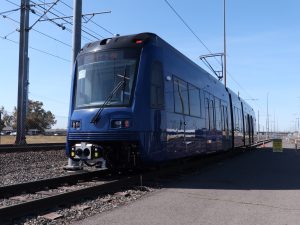SacRT to Rollout New Low-Floor Light Rail Vehicles in Summer 2024
SacRT is getting ready to begin service of new low-floor light rail trains on the Gold and Green lines in summer 2024, and is preparing riders on how to ride the new trains.
Starting in summer 2024, SacRT will replace a portion of our aging fleet with 20 new low-floor trains, which will operate on the Gold Line between Sacramento Valley and Historic Folsom stations, and on the Green Line between 7th & Richards/Township 9 and 13th Street stations.
The Blue Line will continue to operate our current high-floor light rail trains, which still require riders in mobility devices and those unable to climb stairs to use the mini-high ramps at the end of the station platforms.
How to Ride New Low-Floor Light Rail Trains
Once the new low-floor trains start service on the Gold and Green lines, all riders must board from the level platform instead of the mini-high ramps. Riders in mobility devices, walkers or visually impaired can board and exit the train using either one of the two middle doorways by accessing a deployable ramp. Riders press the “wheelchair accessible” button to deploy the ramp. Once the ramp has stopped moving, the doors will open. For visually impaired riders, tactile door indicator tiles will be available closest to the lead car on the station platform.
Riders not needing to use the deployable ramp, press the “door open” button at any of the active doorways either at the ends of the train or at the middle doors if the ramp is not being used.
Inside the train, there are designated seating areas for seniors and persons with disabilities.
When exiting the train, riders must press the “door open” button located on the door to open them. Riders needing to access the ramp would use the “wheelchair accessible” button to deploy the ramp to exit the train.
Note: Customers boarding at Blue Line light rail stations using mobility devices or are unable to climb stairs, will continue to use the mini-high ramp leading to the front train car. Riders will wait at the top of the ramp until the train arrives and the operator deploys the boarding ramp.
About New Low-Floor Trains
The new low-floor vehicles will provide easier access at every doorway, a spacious seating design, and large windows for better light and views. They will feature improved accessibility with wider aisles and areas for bicycles. The new low-floor vehicles will increase overall operational flexibility by providing more access to passengers with disabilities.
The new low-floor light rail trains will only use three new Siemens (S700) light rail vehicles, since there are several city blocks in downtown Sacramento that are not long enough to accommodate four of the S700 vehicles while meeting ADA requirements for the bridge plate to land 8” above the top of the street.
The first new low-floor train was delivered to SacRT in March 2023 and started a rigorous testing process. The first low-floor vehicles are scheduled to be ready for revenue service in summer 2024.

Here is a look at the steps in the testing process:
Step 1: Static Testing: This part of the testing involves a series of evaluations that check the function of every system on board, for example the computer programming; signal, lighting and electrical connections; communication (station announcements, rider announcements and wayside); and even air conditioning and heat. The static testing is expected to take up to two months to complete.
Step 2: Dynamic Testing: This part of the testing is on the line, where staff tests the braking and propulsion. Different weights will be added to the train car to test braking with different loads, to ensure the train is working properly depending on the number of riders onboard. This testing is expected to take up to two months. To complete the dynamic testing phase, light rail service on the Blue Line between Watt/I-80 and Marconi Stations will be shutdown each weeknight between 11 p.m. and the end of service and a bus bridge will be in place to get between those stations. Dynamic testing Blue Line shutdowns are scheduled to begin on May 3, 2023.
Step 3: Burn-in Testing: This part of the testing involves putting the new low-floor vehicle through 1,000 miles of on the track operation. This gives staff an opportunity to address any issues before the vehicle is placed in service. New trains must run a minimum of 1,000 miles of pre-revenue service without any major failures before getting to meet the public. This testing is expected to take approximately one week. Note, if there is a major failure, the 1,000-mile testing process starts again.
The reason for all of these tests is to make sure the new low-floor light rail vehicles are safe and reliable before passengers get on board.
Future Light Rail Vehicles and Blue Line Service
Siemens Mobility will begin production on an additional eight trains later this year. Those trains are expected to be delivered to SacRT in late 2025. SacRT has also ordered an additional 17 vehicles from Siemens Mobility, which are expected to begin production in 2025. To date, SacRT has received funding for a total of 45 new low-floor light rail trains. SacRT is contracted with Siemens Mobility to order up to 76 new vehicles.
SacRT will begin construction on Blue Line station platforms to meet the height requirements of the new low-floor trains in late 2024 – construction is expected to be completed by 2027. Learn more at sacrt.com/modernization.